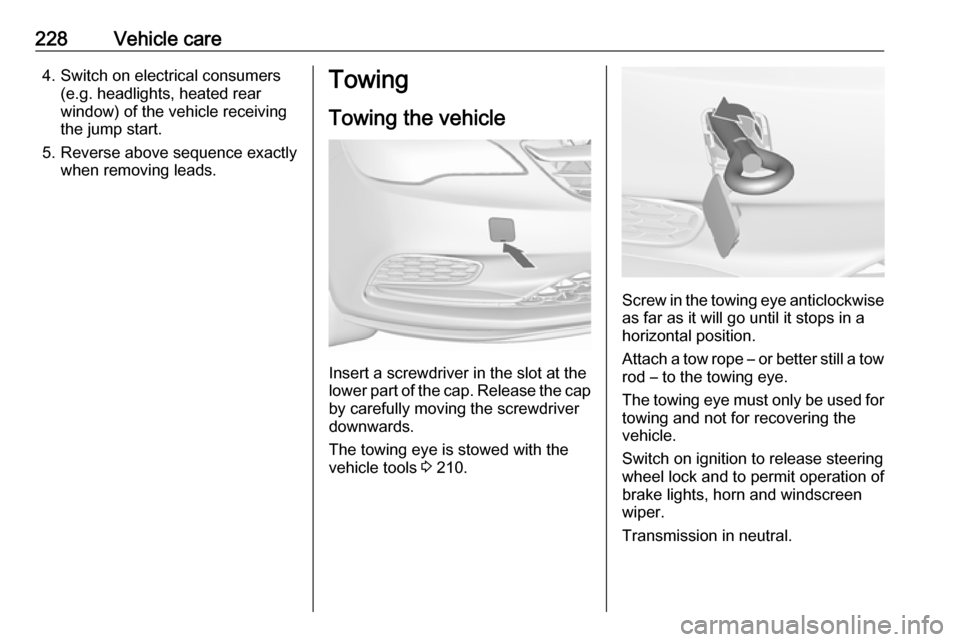ignition OPEL CASCADA 2017 Manual user
[x] Cancel search | Manufacturer: OPEL, Model Year: 2017, Model line: CASCADA, Model: OPEL CASCADA 2017Pages: 263, PDF Size: 7.76 MB
Page 215 of 263

Vehicle care213If w flashes for 60-90 seconds then
illuminates continuously, there is a fault in the system. Consult a
workshop.
After inflating, driving may be
required to update the tyre pressure
values in the Driver Information
Centre. During this time w may
illuminate.
If w illuminates at lower temperatures
and extinguishes after driving, this
could be an indicator for approaching
a low tyre pressure condition. Check
tyre pressure.
Vehicle messages 3 102.
If the tyre pressure must be reduced
or increased, switch off ignition.
Only mount wheels with pressure
sensors, otherwise the tyre pressure
will not be displayed and w
illuminates continuously.
A spare wheel or temporary spare
wheel is not equipped with pressure
sensors. The tyre pressure
monitoring system is not operational
for these tyres. Control indicator willuminates. For the further three
wheels the system remains
operational.
The use of commercially-available
liquid tyre repair kits can impair the
function of the system. Factory-
approved repair kits can be used.
Operating electronic devices or being close to facilities using similar wave
frequencies could disrupt the tyre
pressure monitoring system.
Each time the tyres are replaced, tyre pressure sensors must be
dismounted and serviced. For the
screwed sensor: replace valve core
and sealing ring. For clipped sensor:
replace complete valve stem.
Vehicle loading status Adjust tyre pressure to load condition
according to the tyre information label or tyre pressure chart 3 247, and
select the appropriate setting in the Tyre load menu in the Driver
Information Centre 3 95. This setting
is the reference for the tyre pressure
warnings.The menu Tyre Load only appears if
the vehicle is at a standstill and the
parking brake is applied. On vehicles
with automatic transmission, the
selector lever must be in P.
Select:
● Light for comfort pressure up to
3 people
● Eco for Eco pressure up to
3 people
● Max for full loading
Page 216 of 263

214Vehicle careTyre pressure sensor matching
process
Each tyre pressure sensor has a
unique identification code. The
identification code must be matched
to a new wheel position after rotating the wheels or exchanging the
complete wheel set and if one or more
tyre pressure sensors were replaced. The tyre pressure sensor matching
process should also be performed
after replacing a spare wheel with a
road wheel containing a tyre pressure sensor.
The malfunction light w and the
warning message or code should extinguish at the next ignition cycle.The sensors are matched to the
wheel positions using a relearn tool,
in the following order: left side front
wheel, right side front wheel, right
side rear wheel and left side rear
wheel. The turn signal light at the
current active position is illuminated
until the sensor is matched.
Consult your workshop for service.
There are two minutes to match the
first wheel position, and five minutes
overall to match all four wheelpositions. If it takes longer, the
matching process stops and must be restarted.
The tyre pressure sensor matching
process is as follows:
1. Apply the parking brake.
2. Turn the ignition on.
3. On vehicles with automatic transmission: set the selector
lever to P.
On vehicles with manual
transmission: select neutral.
4. Use MENU on the turn signal
lever to select the Vehicle
Information Menu in the Driver
Information Centre.
5. Turn the adjuster wheel to scroll to
the tyre pressure menu.
6. Press SET/CLR to begin the
sensor matching process. A
message requesting acceptance
of the process should be
displayed.
7. Press SET/CLR again to confirm
the selection. The horn sounds
twice to indicate that the receiver
is in relearn mode.8. Start with the left side front wheel.
9. Place the relearn tool against the tyre sidewall, near the valve stem.Then press the button to activate
the tyre pressure sensor. A horn
chirp confirms that the sensor
identification code has been
matched to this wheel position.
10. Proceed to the right side front wheel, and repeat the procedure
in Step 9.
11. Proceed to the right side rear wheel, and repeat the procedure
in Step 9.
12. Proceed to the left side rear wheel, and repeat the procedure
in Step 9. The horn sounds twice
to indicate the sensor
identification code has been
matched to the left side rear tyre,
and the tyre pressure sensor
matching process is no longer
active.
13. Turn off the ignition.
Page 218 of 263

216Vehicle careIf the tyre pressure must be reduced
or increased on a vehicle with tyre
pressure monitoring system, switch off ignition. After adjusting tyre
pressure switch on ignition and select the relevant setting on the page Tyre
load in the Driver Information Centre
3 95.
Temperature dependency The tyre pressure depends on the
temperature of the tyre. During
driving, tyre temperature and
pressure increase. Tyre pressure
values provided on the tyre
information label and tyre pressure
chart are valid for cold tyres, which
means at 20 °C.
The pressure increases by nearly
10 kPa for a 10 °C temperature
increase. This must be considered
when warm tyres are checked.
The tyre pressure value displayed in
the Driver Information Centre shows
the actual tyre inflation pressure. A
cooled down tyre will show a
decreased value, which does not
indicate an air leak.Tread depth
Check tread depth at regular
intervals.
Tyres should be replaced for safety
reasons at a tread depth of 2-3 mm
(4 mm for winter tyres).
For safety reasons it is recommended
that the tread depth of the tyres on
one axle should not vary by more than 2 mm.
The legally permissible minimum
tread depth (1.6 mm) has been
reached when the tread has worn
down as far as one of the tread wear
indicators (TWI). Their position is
indicated by markings on the
sidewall.
If there is more wear at the front than
the rear, swap round front wheels and rear wheels periodically. Ensure that
the direction of rotation of the wheels
is the same as before.
Tyres age, even if they are not used.
We recommend tyre replacement
every 6 years.
Changing tyre and wheel
size
If tyres of a different size than those
fitted at the factory are used, it may be necessary to reprogramme the
speedometer as well as the nominal
tyre pressure and make other vehicle modifications.
After converting to a different tyre
size, have the label with tyre
pressures replaced.
Page 230 of 263

228Vehicle care4. Switch on electrical consumers(e.g. headlights, heated rear
window) of the vehicle receiving
the jump start.
5. Reverse above sequence exactly when removing leads.Towing
Towing the vehicle
Insert a screwdriver in the slot at the
lower part of the cap. Release the cap
by carefully moving the screwdriver
downwards.
The towing eye is stowed with the
vehicle tools 3 210.
Screw in the towing eye anticlockwise
as far as it will go until it stops in a
horizontal position.
Attach a tow rope – or better still a tow rod – to the towing eye.
The towing eye must only be used for
towing and not for recovering the
vehicle.
Switch on ignition to release steering
wheel lock and to permit operation of
brake lights, horn and windscreen
wiper.
Transmission in neutral.
Page 257 of 263

Customer information255workshop to offer you efficient
maintenance and repair, tailored to
your individual vehicle, each time you
bring it back to the workshop.
The manufacturer will not access
driver's behaviour related information about a crash event or share it with
others except:
● with the consent of the vehicle owner or, if the vehicle is leased,
of the lessee
● in response to an official request of police or similar government
office
● as part of the manufacturer's defense in case of legal
proceedings
● as required by lawIn addition, the manufacturer may use
the collected or received diagnostic
data:
● for the manufacturer's research needs
● to make it available for research needs where appropriate
confidentiality is maintained and
need is shown
● to share summary data which is not tied to a specific vehicle with
other organisations for research
purposesRadio Frequency
Identification (RFID)
RFID technology is used in some
vehicles for functions such as tyre
pressure monitoring and ignition
system security. It is also used in
connection with conveniences such
as radio remote controls for door
locking/unlocking and starting, and in-
vehicle transmitters for garage door
openers. RFID technology in Opel
vehicles does not use or record
personal information or link with any
other Opel system containing
personal information.
Page 260 of 263

258Headlight flash ........................... 116
Headlight range adjustment ......116
Headlights................................... 113 Headlights when driving abroad 116
Head restraint adjustment .............8
Head restraints ............................ 47
Heated mirrors ............................. 32
Heated rear window ..................... 36
Heated steering wheel .................79
Heating ........................................ 55
Heating and ventilation system . 126
High beam ........................... 94, 115
High beam assist ..................94, 115
Hill start assist ........................... 154
Horn ....................................... 15, 80
I Identification plate .....................236
Ignition switch positions .............138
Immobiliser ............................ 30, 94
Indicators ...................................... 85
Information displays...................... 95
Instrument cluster ........................85
Instrument panel fuse box .........207
Instrument panel illumination .....204
Instrument panel illumination control .................................... 122
Instrument panel overview ........... 10
Interactive driving system ...........156
Interior care ............................... 232Interior lighting............................ 122
Interior lights ...................... 123, 204
Interior mirrors .............................. 32
Interruption of power supply ......150
Introduction .................................... 3
ISOFIX child restraint systems ....69
J Jump starting ............................. 226
K Key, memorised settings ..............23
Keys ............................................. 21
Keys, locks ................................... 21
L
Lane departure warning .......92, 178
Lashing eyes ............................... 76
Light switch ................................ 113
Load compartment ................26, 73
Load compartment fuse box ......208
Loading information .....................77
Low fuel ....................................... 94
M
Malfunction indicator light ............90
Manual anti-dazzle ......................32
Manual mode ............................. 149
Manual seat adjustment ...............50
Manual transmission .................. 151
Memorised settings ......................23Mirror adjustment ........................... 8
Misted light covers .....................122
N
New vehicle running-in ..............138
Number plate light .....................203
O Object detection systems ...........164
Odometer ..................................... 85
Oil, engine .......................... 234, 238
OnStar ........................................ 108
Operate pedal ............................... 91
Outside temperature ....................82
Overrun cut-off ........................... 139
P Parking ................................ 19, 141
Parking assist ............................ 164
Parking brake ............................ 152
Parking lights ............................. 122
Particulate filter ........................... 143
Performance .............................. 242
Performing work ........................190
Pollen filter ................................. 134
Power outlets ............................... 84
Power seat adjustment ................53
Power steering.............................. 92
Power windows ............................ 33
Preheating ................................... 93
Puncture ..................................... 220